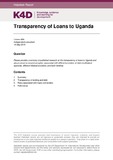Transparency of Loans to Uganda
Abstract
This report focuses on transparency and accountability of debt from both the lender’s and the borrower’s perspectives. Section 2 outlines what transparency entails with regard to borrowers and lenders with a particular focus on the transparency of Ugandan debt. Section 3 focuses on accountability with regard to debt, looking particularly at risks associated with certain types of loans and lenders, and honing in on a select number of issues with particular relevance to the Ugandan context. One of the key findings from the report focuses on the transparency – accurate, comprehensive, and available data – concerning debt plays a critical role in ensuring good lending and borrowing practices. Additionally, evidence suggests that higher levels of fiscal transparency, including information related to debt, provided by a country are associated with lower interest rates and, consequently, with less costly debt. Meanwhile, debt transparency has received heightened policy attention in recent times, notably by the international community through the Addis Ababa Action for Financing for Development, by the G20, and by international financial institutions. The dataset by the Worldbank Group also indicated that some Ugandan individuals and companies have been placed on the World Bank’s sanctions list for fraud and corruption-related offences in relation to previous World Bank-financed projects in Uganda. Operating and adhering to such a sanctions list is one way in which lenders can help contribute to corruption-free finance. Much of the analysis in this review is based on information concerning debt transparency practices by borrowers and lenders found in country-comparative indices, assessments and international databases. The analysis also relies heavily on media reports and other grey literature, including from international financial institutions and advocacy organisations that focus on debt management, budget transparency and aid transparency.
Citation
Mills, L. (2019). Transparency of Loans to Uganda. K4D Helpdesk Report. Brighton, UK: Institute of Development StudiesIs part of series
K4D Helpdesk Report;592Rights holder
© DFID - Crown copyright 2019Collections
- K4D [937]

